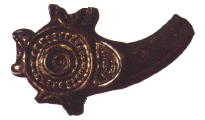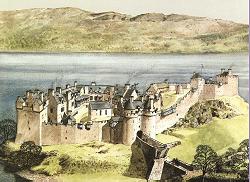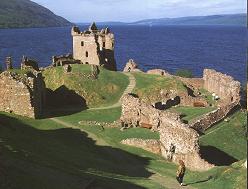

War and Peace
Urquhart Castle was built both as a fortress and as a residence. In war-time its strategic military position provided the lord and those under his protection with as secure a defence as it was possible to achieve. And Urquhart
 Castle witnessed a lot of warlike activity throughout its 500 year history. It figured prominently in the Scots' struggle for independence from England in the fourteenth century; in the fifteenth and sixteenth centuries the castle and glen were frequently raided and plundered, chiefly by the Macdonalds lords of the Isles; and the place was last inhabited by government troops during the Jacobite troubles in the 1690s.
Castle witnessed a lot of warlike activity throughout its 500 year history. It figured prominently in the Scots' struggle for independence from England in the fourteenth century; in the fifteenth and sixteenth centuries the castle and glen were frequently raided and plundered, chiefly by the Macdonalds lords of the Isles; and the place was last inhabited by government troops during the Jacobite troubles in the 1690s.
But Urquhart was not merely a fortress. Its impressive, isolated position was intended equally to proclaim to those living in the glen the power and lordship of their new master. As his chief seat, Urquhart was at the centre of the lord's extensive estate. It served as court, hotel, administrative centre and barracks as well as residence.
Wars of Independence
When Alan Durward died without male heir in 1275, his estate at Urquhart was apparently granted to another powerful Anglo-Norman, John Comyn, lord of Badenoch and Lochaber. It was to prove a short tenure. Twenty one years later, shortly after Edward I of England. 'Hammer of the Scots', had crossed the River Tweed and slaughtered the townsfolk of the border town of Berwick, Urquhart Castle, along with many others throughout the land, had fallen into English hands. But its remoteness from England ensured that it was more difficult to retain.
Sir William Fitzwarine was appointed its constable, or keeper, and almost immediately he was in trouble. In the summer of 1297 Andrew Moray, heir to the large Moray estates and a recent escapee from Chester Castle, spearheaded a night attack on the castle. Among the garrison's dead was the English constable's own son. The attack apparently failed but the English king immediately gave orders that the castle be "so strengthened and garrisoned that no damage may in any way occur to it". His order was clearly not carried out. By the time of Edward's second march into Moray, in 1303, Urquhart was being held by Sir Alexander de Forbes for the Scots. It is not know what became of Sir William Fitzwarine. The Scottish garrison surrendered the castle only after a long and hard fought battle. This time the English constable was Sir Alexander Comyn of Badenoch, who along with the rest of his surname were now violently opposed to the new patriot, Robert the Bruce.
The Bruce was crowned King of Scots at Scone in 1306. By the summer of 1308 he had annihilated the Comyns, taken control of the Great Glen and with it Urquhart Castle. Sir Thomas Randolph, his trusted nephew and brave lieutenant, was given the lordship, and the mighty earldom of Moray, as reward.
The English king's grandson, Edward III, made a further attempt to conquer Scotland following Robert the Bruce's death in 1329 and the defeat of the army of his son and heir, David II, at the battle of Halidon, near Berwick, in 1333. Only five castles kept alive Bruce's cause in the dark days that followed: Dumbarton, Loch Doon, Lochleven, Kildrummy - and Urquhart. An uneasy and fragile peace with England came only with David's return from captivity in 1357 - after more than fifty years of blood shed.
Threat from the West
In 1346, John, 3rd earl of Moray and lord of Urquhart, died. The castle at Urquhart reverted to the Crown. A succession of constables came and went and a good deal of money was spent by the Exchequer in keeping the castle in good repair. This proved a sound investment for the noise of war came again to the glen before the century was out.
This time the threat came not from the south but from the west, the power base of the Macdonalds, Lords of the Isles. The once independent kingdom of the Isles had been forcibly incorporated in the kingdom of Scotland after the victory of Largs in 1263. But
 the Lords of the Isles retained a fierce sense of independence and still exercised a powerful influence along the western seaboard of the country. By the 1390s they sought to extend this by laying claim to the earldom of Ross.
the Lords of the Isles retained a fierce sense of independence and still exercised a powerful influence along the western seaboard of the country. By the 1390s they sought to extend this by laying claim to the earldom of Ross.
The strategic importance of the Great Glen in this mighty struggle explains the cruel Macdonald invasions of Glen Urquhart in the fifteenth and sixteenth centuries. The Lord of the Isles won the first round: Glen Urquhart was seized in 1395 and Charles Maclean of Lochbuy was installed as keeper of the castle. For the next 150 years or so the castle and surrounding lands passed back and forth between the Crown and the Lords of the Isles like a bone between two dogs. The inhabitants of Glen Urquhart could do nothing but suffer the regular harrying, with inevitable consequences. In 1479 the glen was reported to be so utterly devastated that no rents were forthcoming. The castle buildings undoubtedly fell into disrepair.
The Grants of Freuchie
The authority of the Lord of the Isles was dealt a hammer blow in 1476 when John Macdonald was forced to resign the earldom of Ross and withdraw to the west. Nevertheless the threat from that quarter still remained and the king needed a strong personality to restore order and give help to the tenantry. The task was entrusted to George Gordon, 2nd earl of Huntly, at that time the most powerful and influential figure in the north-east. He leased the lands in Glen Urquhart to Sir Duncan Grant of Freuchie.
In 1509 Duncan's grandson, John Grant of Freuchie, known as the 'Red Bard', was given the lordship of Urquhart, including the castle, holding direct of the Crown. Among other things, King James IV ordered him: "to repair or build at the castle a tower, with an outwork or rampart of stone and lime, for protecting the lands of the people from the inroads of thieves and malefactors; to construct within the castle a hall, chamber and kitchen, with all the requisite offices, such as a pantry, bakehouse, brewhouse, oxhouse, kiln, cot, dovegrove and orchard, with the necessary wooden fences".
The chances of Grant realising the king's wishes immediately were slight. The king's death on the battlefield of Flodden, in Northumberland, in 1513, prompted the new Lord of the Isles, Sir Donald Macdonald of Lochalsh, to pour his clansmen once more into Glen Urquhart, looting and killing the inhabitants and capturing the castle. They stayed three years, stripping the tenants of all they owned. In 1527, Hector Boece described the scene: "In this countre (the old earldom of Ross) was the famous castel of Urquhart: quhilk the rewinous wallis remains yet in gret admiration of pepill".
Worse followed in 1545. It was now the Scots' distraction with the War of the 'Rough Wooing' (in which Henry VIII of England attempted by force to have his son and heir, the future Edward VI, married to the infant Mary Queen of Scots) that encouraged the Macdonalds, with their allies the Camerons of Lochiel, to besiege and take the castle again, and loot once more the homesteads of the glen. That was the last the folk in the glen were to see of the men from the west. The Grants probably then carried out major repairs to the medieval castle and built new accommodation, including the lofty towerhouse, their private lodging. Work was still progressing into the following century.The Twilight of the Castle
By 1600, though, the days of the castle as a noble residence were drawing to a close. Landowners throughout the country were abandoning their medieval castles and building better residences in more acceptable locations. The rocky promontory that had served their predecessors well down the centuries no longer held any attraction for the Grants of Freuchie. By the middle of the century it is doubtful if Grant himself was in residence. The castle buildings are more likely to have been given over to folk from the glen. The strategic importance of the castle was also in decline as the country became more peaceful and stable under King James VI of Scotland and I of England. During the Civil War in the 1640s the castle played little part except as a handy place to loot. A report in 1647 described the "mansione and maner place of Wrquhart" as being utterly spoiled and plundered of all its "pleneishing, goodis and geir". And when Cromwell's troops came to the Great Glen in the 1650s, they built great forts at either end - Inverlochy (now Fort William) and Inverness - but chose not to garrison the castle. A ship (called a "statly friggott") was deemed sufficient to patrol Loch Ness.
 The Revolution of 1689, which saw the flight into exile of the last Stewart king, James VII of Scotland and II of England, and his replacement by the Protestant William and Mary, saw the castle garrisoned for the last time. Three companies of poorly armed Highlanders under Captain James Grant (about 200 officers and men) held the castle for the new king and queen against a Jacobite force estimated at 600 strong. The latter were apparently beaten off.
The Revolution of 1689, which saw the flight into exile of the last Stewart king, James VII of Scotland and II of England, and his replacement by the Protestant William and Mary, saw the castle garrisoned for the last time. Three companies of poorly armed Highlanders under Captain James Grant (about 200 officers and men) held the castle for the new king and queen against a Jacobite force estimated at 600 strong. The latter were apparently beaten off.
When the garrison finally left in 1692 the laird of Grant complained to the authorities that they had blown up some of the buildings to render the castle untenable. The results of their handiwork are still visible beside the gatehouse. Grant's outlandish compensation claim of £44,000 was agreed to by Parliament in 1695, perhaps on the understanding that it would never be paid, Scotland being in the grip of severe economic depression.
Urquhart Castle was never repaired.
The buildings rapidly fell into decay. Folk came from the glen and took the best of the stonework, the lead from the roofs and the wood from the interiors. On 19 February, 1715 it was reported that:
"the Castell of Urquhart is blowen down with the last storme of wind, the south-west side thereoff to the laich woult (lower vault)".
The gaping hole in one side of the towerhouse bears silent witness to this unfortunate event.
Map Page
History of the Castle
Tower House
Drawbridge and Bailey
Loch Ness Home Page
Highlands of Scotland Menu
Back to Legend of Nessie